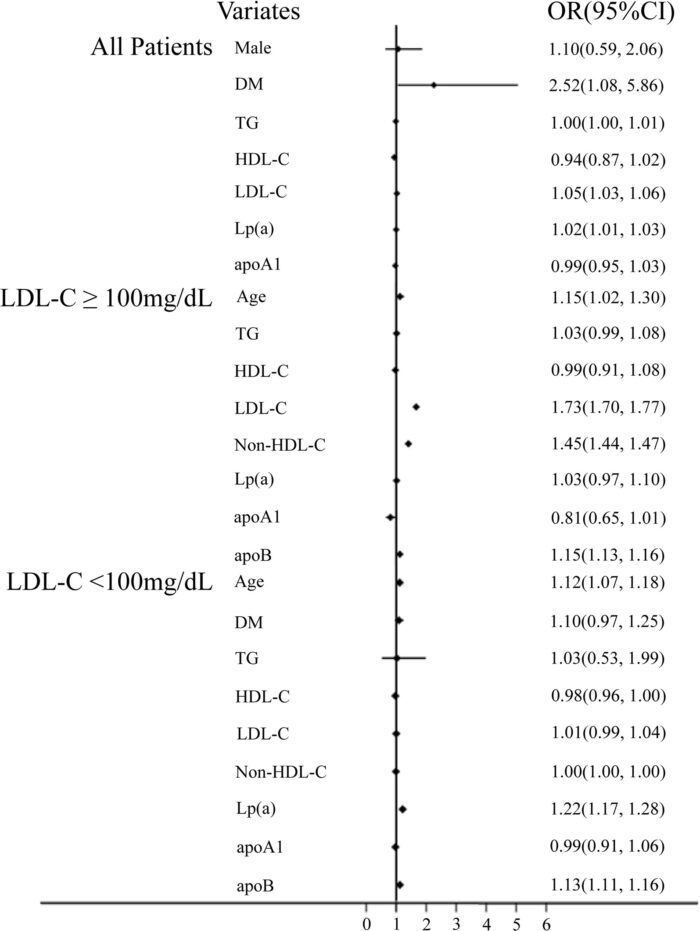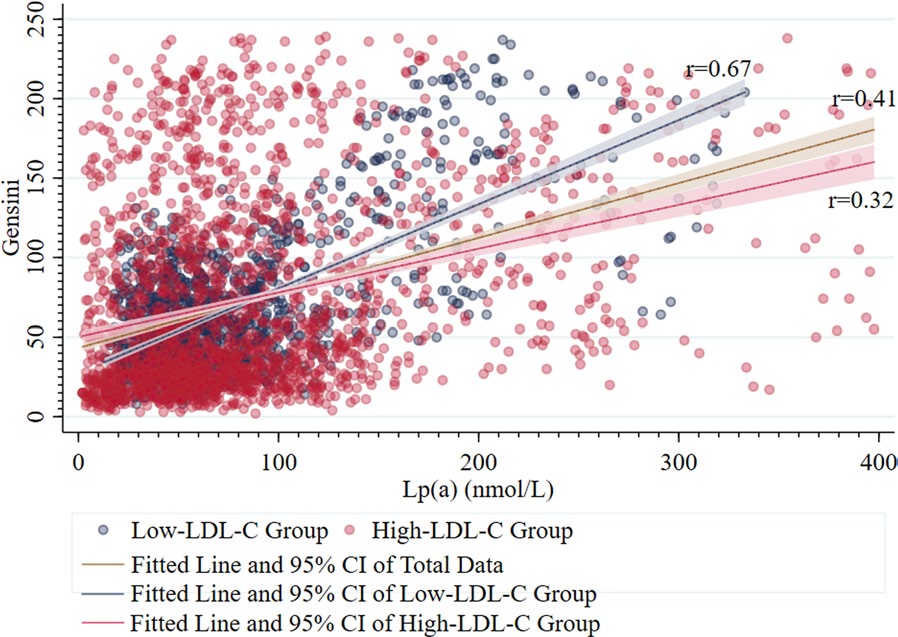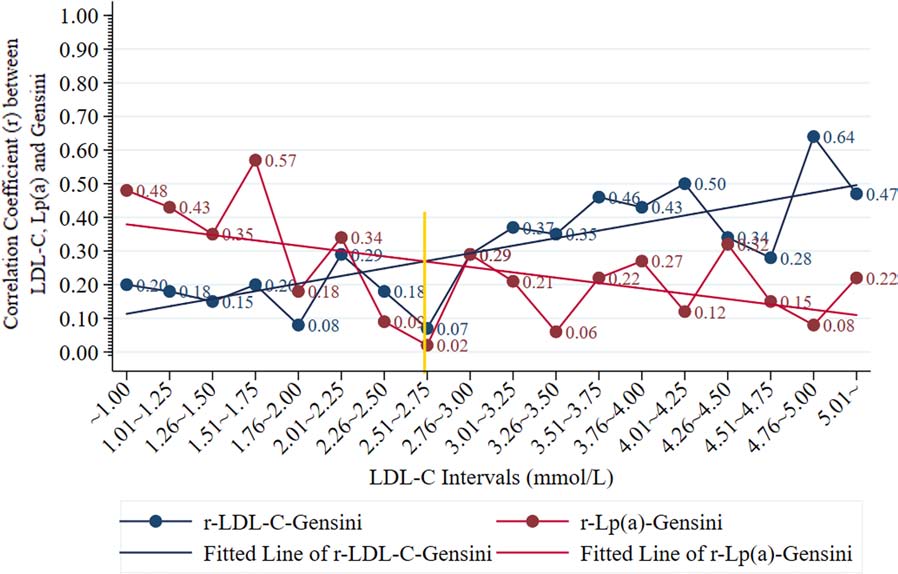Li C. BMC Cardiovasc Disord. 2021;21:41.
The risk factors of ASCVD are both Lp(a) and low-density LDL-C. However, there was a disparity point in LDL-C and Lp(a) control. The suitable level of LDL-C and Lp(a) is still lacking for the inhibition of ASCVD. Thus, Li C, et al., conducted a study to discover the association among LDL-C, Lp(a) and coronary atherosclerotic lesion in a group of patients with exact evidence of coronary atherosclerosis, and the association strengths within different LDL-C concentrations were compared to determine the balance point of LDL-C and Lp(a) in ASCVD inhibition.
3449 patients with the diagnosis of CAHD were analysed in a single-center cross-sectional clinical study. 2771 patients with any coronary stenosis ≥ 50% were distributed to CAHD Group, 678 patients with all coronary stenosis < 50% were distributed to non-CAHD Group as per the CAG results. The CAGs were executed for patients who had typical or untypical unstable angina pectoris along with myocardial ischemic changes in electrocardiogram. Patients were subdivided with the recommended LDL-C concentration and executed subgroup analysis in high- LDL-C Group (LDL-C ≥ 100 mg/dL) and low-LDL-C Group (LDL-C < 100 mg/dL). Logistic regression investigations were conducted in all patients and subgroups. Spearman correlations were executed to analyse the association among Lp(a) and Gensini Score. In patients with different LDL-C concentration, Gensini Score was executed.
In the Logistic regression of all patients, 3 of 7 variables were risk factors of CAHD, which showed diabetes (OR: 2.52, 95% CI: 1.08–5.86), LDL-C (OR: 1.05, 95%CI: 1.03–1.06), and Lp(a) (OR: 1.02, 95%CI: 1.01– 1.03). In the logistic regression of High-LDL-C group, 4 of 8 elements turned to be risk factors for CAHD, which showed age (OR: 1.15, 95%CI: 1.02–1.30), LDL-C (OR: 1.73, 95%CI: 1.70–1.77), non-HDL-C (OR: 1.45, 95%CI: 1.44–1.47), and ApoB (OR: 1.15, 95%CI: 1.13–1.16). Although in Low-LDL-C group, between the 9 items, age (OR: 1.12, 95%CI: 1.07–1.18), Lp(a) (OR: 1.22, 95%CI: 1.17–1.28) and ApoB (OR: 1.13, 95%CI: 1.11–1.16) ceased as CAHD risk factors (Figure 1).

Figure 1: Forest Illustration of Logistic Regression for CAHD in All Patients, High LDL-C Group and Low LDL-C Group. As 95.3% patients are at moderate- or low-risk of CVD, we set LDL-C = 100 mg/dL as the cutoff point as the Guidelines recommended. Low-LDL-C Group: patients with LDL-C < 100 mg/dL. High-LDL-C Group: patients with LDL-C ≥ 100 mg/dL
Positive linear correlations were reported between Lp(a) and Gensini in the low-LDL-C group, the high-LDL-C group and the cumulative Spearman correlation coefficient r of 0.67, 0.32 and 0.41, respectively (p < 0.001). In Low-LDL-C Group, Lp(a) was more pertinent to Gensini as compared to the other two group (p < 0.001) (Figure 2).

Figure 2: Scatter Plot of Lp(a)-Gensini Correlation in Low-LDL-C Group, High-LDL-C Group and Total Patients. The LDL-C concentration was converted from mg/dL to mmol/L to facilitate the determination of the LDL intervals, with LDL-C (mmol/L) = 0.0259 * LDL-C (mg/dL). r-LDL-C-Gensini: correlation coefficient r in the Spearman correlation analysis of LDL-C and Gensini; r-Lp(a)-Gensini: correlation coefficient r in the Spearman correlation analysis of Lp(a) and Gensini
Along with an improvement in LDL-C concentration, the LDL-C-Gensini association increased. Even though the association of Lp(a)-Gensini was reduced with the increasing LDL-C level (Figure 3).

Figure 3: Simple Scatter plot with Fitted Lines of the Correlation Coefficient rs in the Pearson Correlation of LDL-C, Lp(a) and Gensini in Different LDL-C Intervals.
The highest coefficient r of LDL-C-Gensini association was 0.64 in the LDL-C of 4.76–5.00 mmol/L, although the lowest r was 0.07 in the LDL-C of 2.51– 2.75 mmol/L. The fitted lines of LDL-C-Gensini and Lp(a)-Gensini correlation coefficient rs divided near the point of LDL-C = 2.7 mmol/L (104 mg/dL).
Thus, it was concluded that in patients with LDL-C < 100 mg/dL, Lp(a) was the risk factor of coronary atherosclerosis heart disease, preferably as compared to patients with LDL-C ≥ 100 mg/dL. The LDL-C concentration affected the association among Lp(a) and coronary atherosclerosis lesion, and the association was potent than LDL-C when LDL-C less than 104 mg/dL.
ASCVD: Atherosclerotic cardiovascular disease; LDL-C: Low-density lipoprotein cholesterol; Lp(a): Lipoprotein(a); apo(a): apolipoprotein(a)1; apoB: apolipoprotein B; CAHD: Coronary atherosclerotic heart disease; CAG: Coronary angiography; OD: Odds ratio; CI: Confidence interval

